warship
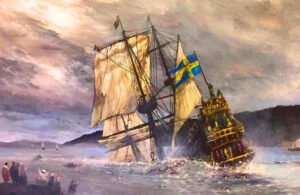
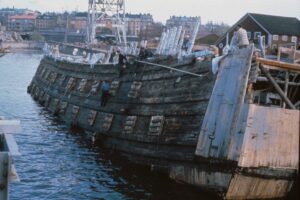 Vasa is a beautiful Swedish warship built between 1626 and 1628. For a warship, the ship was anything but plain. It was a very ornate, which is odd for a warship…at least as we see them today. The ship was built on the orders of the King of Sweden Gustavus Adolphus as part of the military expansion he initiated in a war with Poland-Lithuania, which took place between 1621–1629. Vasa was constructed at the navy yard in Stockholm under a contract with private entrepreneurs in 1626–1627. The ship was armed primarily with bronze cannon cast in Stockholm specifically for the ship. The king had her richly decorated as a symbol of his ambitions for Sweden and for himself. When she was done…she was not only stunningly beautiful, but she was also one of the most powerfully armed vessels in the world. All that was great, but Vasa was also dangerously unstable, with too much weight in the upper structure of the hull. That fact didn’t faze the king, who despite the lack of stability, of which he was informed, ordered Vasa to sea.
Vasa is a beautiful Swedish warship built between 1626 and 1628. For a warship, the ship was anything but plain. It was a very ornate, which is odd for a warship…at least as we see them today. The ship was built on the orders of the King of Sweden Gustavus Adolphus as part of the military expansion he initiated in a war with Poland-Lithuania, which took place between 1621–1629. Vasa was constructed at the navy yard in Stockholm under a contract with private entrepreneurs in 1626–1627. The ship was armed primarily with bronze cannon cast in Stockholm specifically for the ship. The king had her richly decorated as a symbol of his ambitions for Sweden and for himself. When she was done…she was not only stunningly beautiful, but she was also one of the most powerfully armed vessels in the world. All that was great, but Vasa was also dangerously unstable, with too much weight in the upper structure of the hull. That fact didn’t faze the king, who despite the lack of stability, of which he was informed, ordered Vasa to sea.
Vasa’s maiden voyage was an exciting moment for everyone in the area. On August 10, 1628, she set sail from the Stockholm navy yard and after encountering a wind that was barely stronger than a breeze, she sank after sailing roughly 1,400 yards. Seriously, that has to be the shortest maiden voyage on record…for all time. Vasa quickly fell into obscurity after most of her valuable bronze cannon were salvaged in the 17th century, which is odd, because they knew where she was and if they were able to pull the cannon up, why would they not take anything else. Nevertheless, she sat there until she was once again located in the late 1950s in a busy shipping area in Stockholm harbor. Amazingly, the ship was salvaged with a largely intact hull in 1961. She was temporarily housed in a museum called Wasavarvet (“The Vasa Shipyard”) until 1988, when she was moved permanently to the Vasa Museum in the Royal National City Park in Stockholm. Today, the ship is one of Sweden’s most popular tourist attractions. Since her recovery and placement in 1961, over 35 million visitors have seen the ship. Vasa has become a widely recognized symbol of the Swedish Empire…something I’m not sure I would like if I were the king, because while she is beautiful, she is unstable, and what leader would want “a lack of stability” to be part of their nation’s symbol.
It is said that the order to sail was the result of a combination of factors. The king, who was leading the army in Poland at the time of her maiden voyage, was impatient to see her take up her station as flagship of the reserve squadron at Älvsnabben in the Stockholm Archipelago, being the biggest one. Unfortunately, the king’s subordinates lacked the political courage to openly discuss the ship’s problems or to push to have the maiden voyage postponed. Of course, there was an inquiry by the Swedish Privy Council to find out who was responsible for the disaster. Nevertheless, in the end, no one was punished.
When the recovery crew went in to bring Vasa and her contents to the surface once again in 1961, they found thousands of artifacts, among them many items of clothing, weapons, cannon, tools, coins, cutlery, food, drink 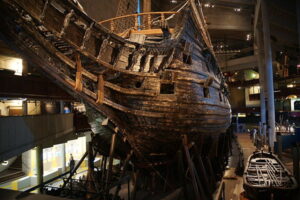
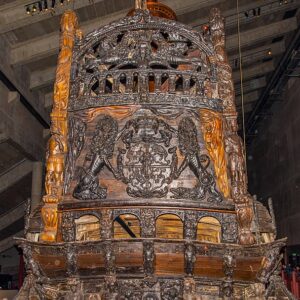 and six of the ten sails. Marine archaeologists also found the remains of at least 15 people in and around Vasa’s hull. The artifacts and the ship herself have provided scholars with invaluable insights into details of naval warfare, shipbuilding techniques, and everyday life in early 17th-century Sweden. Without question, Vasa is the world’s best preserved 17th century ship. The wreck of Vasa continually undergoes monitoring and further research on how to preserve her.
and six of the ten sails. Marine archaeologists also found the remains of at least 15 people in and around Vasa’s hull. The artifacts and the ship herself have provided scholars with invaluable insights into details of naval warfare, shipbuilding techniques, and everyday life in early 17th-century Sweden. Without question, Vasa is the world’s best preserved 17th century ship. The wreck of Vasa continually undergoes monitoring and further research on how to preserve her.
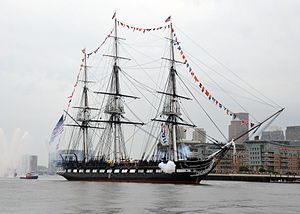 I think most of us have heard of the Barbary Coast at some point. The coast was named for its Berber inhabitants, but it was the trouble that occurred there that has made it a name to remember. The Barbary pirates, who were sometimes called Barbary corsairs or Ottoman corsairs, were pirates and privateers who operated from North Africa, mostly near the ports of Salé, Rabat, Algiers, Tunis, and Tripoli, which is now the area known as the Barbary Coast. In addition to seizing ships, they engaged in Razzias, raids on European coastal towns and villages, mainly in Italy, France, Spain, and Portugal, but also in the British Isles, the Netherlands and as far away as Iceland. Their main goal was to capture Christian slaves for the Ottoman slave trade, as well as the general Arabic market in North Africa and the Middle East. The pirates captured thousands of ships and repeatedly raided coastal towns.
I think most of us have heard of the Barbary Coast at some point. The coast was named for its Berber inhabitants, but it was the trouble that occurred there that has made it a name to remember. The Barbary pirates, who were sometimes called Barbary corsairs or Ottoman corsairs, were pirates and privateers who operated from North Africa, mostly near the ports of Salé, Rabat, Algiers, Tunis, and Tripoli, which is now the area known as the Barbary Coast. In addition to seizing ships, they engaged in Razzias, raids on European coastal towns and villages, mainly in Italy, France, Spain, and Portugal, but also in the British Isles, the Netherlands and as far away as Iceland. Their main goal was to capture Christian slaves for the Ottoman slave trade, as well as the general Arabic market in North Africa and the Middle East. The pirates captured thousands of ships and repeatedly raided coastal towns.
In order to combat the Barbary pirates, the United States Navy built the USS Constitution, which was a 44 gun 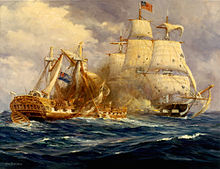 frigate. It was first launched on this day, October 21, 1797, from Boston Harbor. The USS Constitution performed well fighting off pirates in the area, and in 1805, a peace treaty was signed on her deck. When the conflict was over, the ship returned and to its base in Boston. I’m sure the pirates knew full well, that it would return if needed. The ship didn’t have to go back and flex it’s muscle again…at least not there.
frigate. It was first launched on this day, October 21, 1797, from Boston Harbor. The USS Constitution performed well fighting off pirates in the area, and in 1805, a peace treaty was signed on her deck. When the conflict was over, the ship returned and to its base in Boston. I’m sure the pirates knew full well, that it would return if needed. The ship didn’t have to go back and flex it’s muscle again…at least not there.
During the War of 1812, the USS Constitution won its nickname, Old Ironsides, after defeating the British warship, Guerriére in a furious battle off the coast of Nova Scotia. It was said that the British shots just bounced off the sides of the USS Constitution, as if they were made of iron, rather than wood, The Guerriére was thought to be invincible, but that was proven to be a fallacy. On the afternoon of 19 August 1812, about 400 miles southeast of Halifax, Nova Scotia, the Guerriére saw a sail in the distance, bearing down 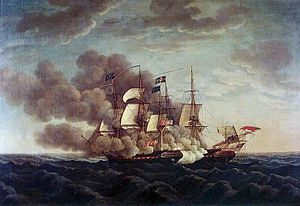 on them. It was the USS Constitution, so the Guerriére prepared for action. Captain James Dacres mustered 244 men and 19 boys, and set them to prepare for battle. When the enemy hoisted American colors, Captain Dacres permitted the Americans in his crew to quit their guns. When the fight was over, nine men were killed and thirteen were wounded. Captain Dacres surrendered his badly damaged ship in an effort to save the lives of the remaining crew, the crew were taken prisoner, and the crew of the USS Constitution set the ship on fire. That was the end of the Guerriére, and Old Ironsides was born. The USS Constitution was retired from service in 1881, and served as a receiving ship until designated a museum ship in 1907.
on them. It was the USS Constitution, so the Guerriére prepared for action. Captain James Dacres mustered 244 men and 19 boys, and set them to prepare for battle. When the enemy hoisted American colors, Captain Dacres permitted the Americans in his crew to quit their guns. When the fight was over, nine men were killed and thirteen were wounded. Captain Dacres surrendered his badly damaged ship in an effort to save the lives of the remaining crew, the crew were taken prisoner, and the crew of the USS Constitution set the ship on fire. That was the end of the Guerriére, and Old Ironsides was born. The USS Constitution was retired from service in 1881, and served as a receiving ship until designated a museum ship in 1907.
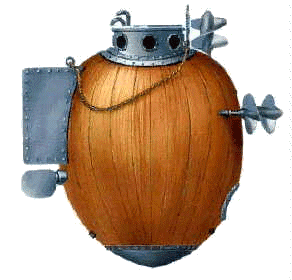 When most of us think of submarines, we think of the modern day nuclear subs that are basically underwater mobile cities, but as we all know, submarines have been around a lot longer…just how long was a surprise to me, although a learned history buff might not have been shocked at all. The idea of being able to operate underwater, actually dates back to ancient times when people used a hollow stick to breathe underwater. I’m not sure how successful any of those early attempts were, especially in the use of a vehicle of some kind, but probably not successful enough to warrant any kind of mass production.
When most of us think of submarines, we think of the modern day nuclear subs that are basically underwater mobile cities, but as we all know, submarines have been around a lot longer…just how long was a surprise to me, although a learned history buff might not have been shocked at all. The idea of being able to operate underwater, actually dates back to ancient times when people used a hollow stick to breathe underwater. I’m not sure how successful any of those early attempts were, especially in the use of a vehicle of some kind, but probably not successful enough to warrant any kind of mass production.
The first documented record of a submarine being used in combat, came as quite a surprise to me. The submarine, named Turtle, but usually called American Turtle, was used during the American Revolutionary War in 1776. Turtle was built in Old Saybrook, Connecticut in 1775 by American, David Bushnell as a means of attaching explosive charges to ships in a harbor. Turtle was designed  for use against British Royal Navy vessels occupying North American harbors. Then Connecticut governor, Jonathan Trumbull recommended the invention to George Washington. Even though Washington had his doubts, he provided funds and support for the submarine’s development and testing.
for use against British Royal Navy vessels occupying North American harbors. Then Connecticut governor, Jonathan Trumbull recommended the invention to George Washington. Even though Washington had his doubts, he provided funds and support for the submarine’s development and testing.
By 1776, Turtle was ready for testing. Several attempts were made by submarine operator, Sergeant Ezra Lee to affix explosives to the undersides of British warship HMS Eagle on September 7, 1776 in New York Harbor. Unfortunately, all of them failed, and Turtle’s transport ship was sunk later that year by the British…with Turtle aboard. Bushnell claimed to have recovered Turtle, but that has not been proven. Replicas of Turtle have been built and they are on display at the Connecticut River Museum, the U.S. Navy’s Submarine Force Library and Museum, the Royal Navy Submarine Museum and the 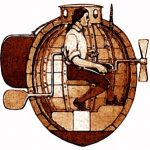 Oceanographic Museum in Monaco.
Oceanographic Museum in Monaco.
While Turtle was not successful, it was innovative, and it inspired other inventors to come up with ways that a submarine could be successful in combat, as well as exploration. I have to wonder if David Bushnell, or any of the other early inventors of crafts that operated under water had any idea how far below the surface of the oceans the submarine would eventually be able to go. Think of all the ships and planes that would never have been located, if we had no way to peer beneath the surface, and how much cargo would never have been recovered if we could not travel far below to not only locate, but salvage the cargo lost at sea. The submarine is truly amazing.

